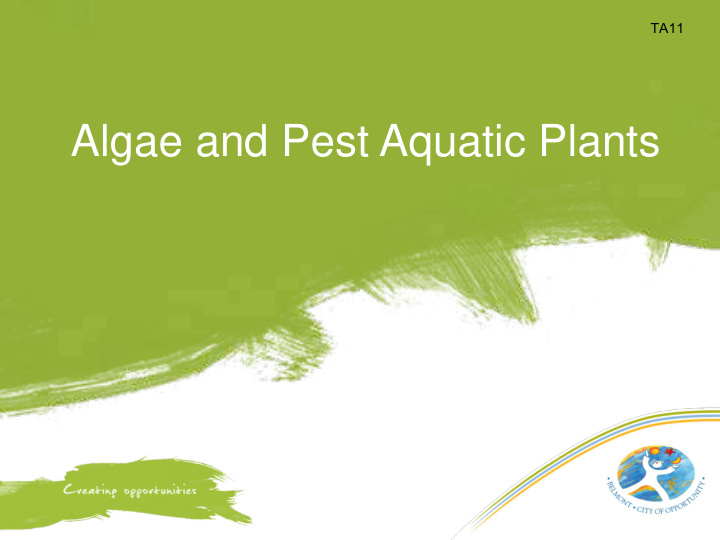



TA11 Algae and Pest Aquatic Plants
TA12 Scope • Aquatic (Freshwater) Systems • The plants and plant like organisms which live there • What stresses these systems? • The outcomes of these stresses • What we can do?
TA13 Aquatic systems • Aquatic systems (lakes, wetlands, and rivers) generally exist in a ‘balanced’ state – Tomato Lake – Freshwater Lake – The Swan River • The aquatic organisms which live there are sensitive to changes in their physical environment
TA14 Aquatic systems • Any changes in their physical environment results in a direct change to specie presence/diversity and abundance – e.g. Most aquatic organisms have a limited range in salt and temperature tolerance – a major increase or decrease results in their death – Increased sunlight on aquatic plants or “plant like” organisms can enable favourable environments resulting in population growth
TA15 Aquatic systems • Aquatic organisms in these systems? – Plants and algae (primary producers) – Macro-invertebrates – Fish – Turtles – Birdlife
TA16 Algae • Algae and Cyanobacteria (blue-green algae) exist in the environment at all times and are important life forms – “feed” off nutrients in the water – Provide food and habitat for macro-invertebrates and fish – Can grow exponentially when the environment permits – “Good” and “bad” species
TA17
TA18
TA19 Aquatic Plants • Native aquatic plants are critical components of freshwater systems – Provide food and habitat for macro-invertebrates and fish – Reduce nutrient levels in the system – less nutrients can result in reduced algal blooms – Exist as “true plants” or floating plants – Can grow exponentially when the environment permits – Can be opportunistic – grow during a particular time of year
TA20 Aquatic Plants
TA21
TA22 Stresses • Excess nutrients results in eutrophication – a state of the environment where the aquatic system is “saturated” with nutrients – results in an exponential growth of primary producers (plants and algae blooms)
TA23 Stresses • Algal and plant blooms can – Outcompete other organisms – smother the environment (risk to aquaculture) – Cause bad odours – Result in fish kills • Directly - toxic • Indirectly - deplete oxygen – Toxic algal blooms can result in the closure of recreational waterways due to public health concerns (SRT, DoH)
TA24 Can we manage it? • Various methods – Direct and indirect chemical or biological controls • Direct: algaecides (i.e. Alum dosing) – non-selective and kill other freshwater organisms – Not commonly used in “natural” environments • Indirect: Phoslock or soilzyme which help reduce nutrient availability – Soilzyme currently applied to City lakes -Tomato Lake, Freshwater Lake, Centenary Park Lake
TA25 Can we manage it? • Various methods – Physical management • Manual removal: only possible with filamentous plants and algae – Expensive, labour intensive and can disturb “stored” nutrients in sediment • Aeration/ oxygenation: using aerators, mix the water column and prevent stratification – Increases the amount of oxygen available to all organisms = increase natural uptake of nutrients – Reduces risk of bad odours and fish kills
TA26 Best Practice • Reduce nutrient loads going to aquatic systems – Community awareness (i.e. washing cars on the lawn, not putting grey water to the drain) – Monitor land uses (i.e. Belmont Environmental Assessment Program, Stormwater monitoring) – Vegetated buffers between irrigated and fertilised areas surrounding water bodies – fertiliser wise low/no Phosphorus fertilisers or fertiliser wise gardens – Encourage native aquatic/ wetland flora (keep the balance)
TA27 Thank you. Q&A?
Recommend
More recommend